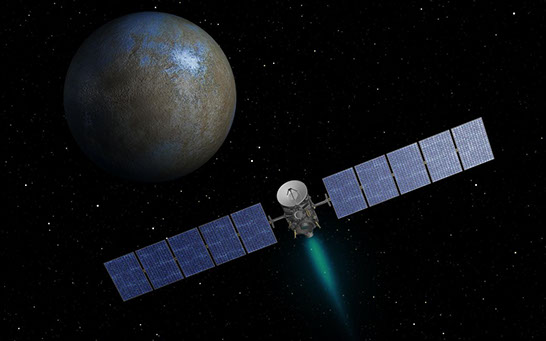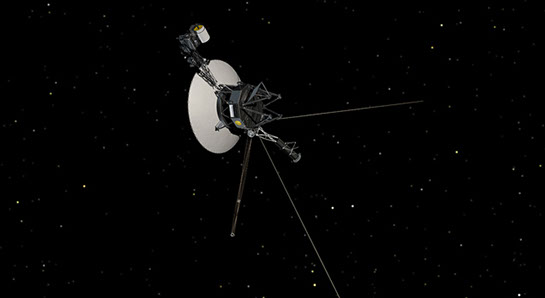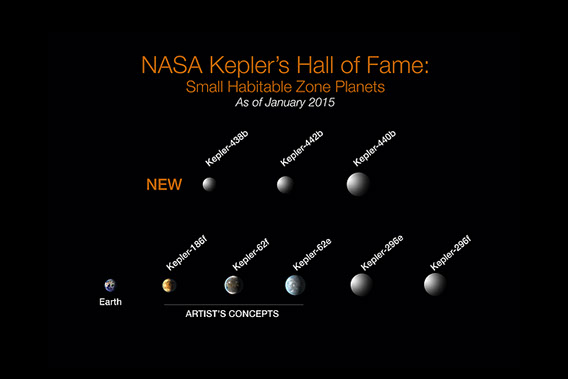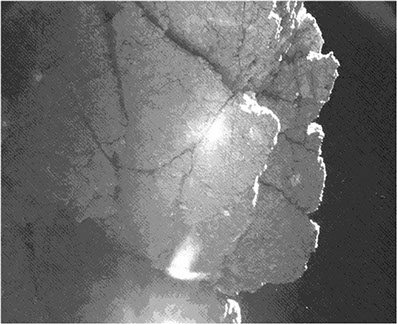

January 2015
Milky Way Black Hole Megaflare
Sagittarius A*, or Sgr A* for short, is the supermassive black hole that lays at the center of the Milky Way. NASA's Chandra X-ray space telescope has been observing Sgr A* as a huge cloud of gas (called G2) moved close to it. Three megaflares of X-rays were released by the black hole, the first in early 2012, then the second in Sept 2013 and the latest in Oct 2014. The 2013 flare was 400 times brighter than the black hole's usual state, with the 2014 flare 200 time brighter. But G2 was closest to the black hole in spring of 2014. So scientists are thinking these flares must have been caused by something else.
There are two leading theories. The first is that an asteroid came too close to the black hole and was sucked in. As objects get too close to a black hole the cross what is called the event horizon. The event horizon is basically the point of no return. Once an object crosses the event horizon it begins a downward spiral into the black hole, much like water going down a drain.
If a large asteroid crossed the event horizon it would be torn apart by the gravity. The bits then would spiral into the black hole emitting X-rays on the way in. If an asteroid was sucked in, it would spiral in in a matter of hours and then be gone forever. This is just how long the megaflares that were detected lasted.
The second theory says magnetic fields could have caused the bursts. The magnetic field lines in the gas flowing toward Sgr A* could be densely packed and tangled producing flares of X-rays. This pattern has been seen on our sun.
Observing a small amount of matter falling into a black hole is a rare occurrence. Chandra's observations will help scientists put together another piece of the puzzle to attempt to unlock how these strange incredible objects we call black holes work.
Black Hole Merger
Supermassive black holes are found at the center of galaxies. Our Milky Way has a supermassive black hole at the center of it also. The black holes and their host galaxies are thought to develop at the same time.
Sometimes, galaxies get close to each other and merge into one. But what of the black holes? Do they merge also? Theory predicts they will, but it has never been observed. Now, data of distant Quasars may have seen the merging of two black holes.
Quasars are extremely high bursts of X-rays and Gamma rays produced by objects being pulled into the black hole. In a galaxy's early life a lot a matter is close to the black hole and there is a lot of activity. At this time Quasars are produced.
Scientists at Cal Tech have been studying distant Quasars. Ground telescopes continually monitor Quasars. Until now, black holes in galaxies about to merge have been still too far apart to observe what will happen. It will take hundreds of thousands of years before they interact. But recent data from Quasar PG 1302-102 may have revealed two black holes merging.
PG 1302-102 is producing a periodic optical signal. Usually Quasars produce a random chaotic signal. But in this case a smooth up and down signal is being produced. The scientist pulled data from PG 1302-102 going back 20 years and the periodic signal as been constant over that time.
The team analyzed the light spectrum of the Quasar. Black holes do not emit light, but the objects being pulled in do. As the object swirls its way into the black hole it heats up into a glowing plasma. Analyzing the spectrum and using the Doppler effect you can determine the speed and direction of an object.
It was found that PG 1302-102 has two emission lines, each with different speeds. This suggests that there is something else there causing this. Most likely, a second black hole is the cause.
There are several possible reasons for the periodic signal but all require a binary system, as in two black holes.
Dawn approaches Ceres
NASA's Dawn spacecraft will enter orbit around the dwarf planet Ceres on 6 March 2015. Ceres is located in the asteroid belt between Mars and Jupiter. It has an average diameter of 590 miles (950 km), about the size of the state of Texas. Ceres is the largest body in the asteroid belt.
Dawn was launched in 2007 and first visited the protoplanet Vesta. Vesta is also located in the asteroid belt, the second largest object found there at 326 miles (525 km) across. Dawn orbited Vesta for 14 months in 2011 and 2012. When Dawn enters orbit around Ceres it will become the first spacecraft to orbit two different objects.
Ceres and Vesta are completely different from each other. Vesta is older and retained very little water. Ceres is believed to have an icy mantle and possibly an ocean beneath the ice.
Dawn is powered by ION propulsion. It can travel more efficiently than chemical propulsion spacecraft. In an ION engine an electrical charge is applied to xenon gas and charged metal grids accelerate the xenon particle out of the thruster. The particles push back on the thruster as they exit causing the spacecraft to move. Dawn's ION engines have now completed five years of accumulated thrust time, more than any other spacecraft.
Dawn recently emerged from traveling around the sun and has made contact with earth. Preparations are now underway for its approach and orbit in the next month. Ceres is a mystery and anything found there will be new and exciting.
NASA has another spacecraft on its way to another dwarf planet. This summer, New Horizons will arrive at Pluto.

Credit: NASA/JPL-CalTech
Upcoming Launches
Date: January 29
Launch Vehicle: Delta II
Launch Site: LC 2, Vandenberg AFB, Calif.
Description: Launch of Soil Moisture Active Passive (SMAP) mission to measure and map Earth's soil moisture and freeze/thaw state to better understand terrestrial water, carbon and energy cycles.
Voyager 1 Update
Voyager 1 is traveling through interstellar space. The first spacecraft to leave the solar system. Since October 2012, Voyager 1 has observed three shock waves. These shock waves are formed when the sun sends out a coronal mass ejection producing a wave of pressure. The pressure wave travels across space and eventually hits interstellar plasma creating the shock wave.
The detection of a shock wave was evidence that Voyager 1 had reached interstellar space. The second wave that Voyage experienced was of higher plasma density than the first. This wave was experience in April and May of 2013. In February of 2014 Voyager encountered a third wave. As of the November data received the shock wave is still going on. Voyager has traveled 250 million miles (400 million km) in that period.
This produced new questions about the shock waves and interstellar space. No one knows why this event has lasted so long. Questions include how fast the wave is moving and its size.
The plasma density is higher the further Voyager goes. Is it because interstellar space is denser or is it because of the shock wave? There is speculation that shock waves can travel twice as far out as Voyager is now. But no one knows for sure. Voyager is charting unknown territory.
Voyager 1 and its twin Voyager 2 were launched in 1977. Voyager 2 is expected to enter interstellar space in a few years.

Credit: NASA/JPL-CalTech
1000 Exo-planets and Counting
NASA's Kepler space telescope has verified its 1000th exo-planet. An additional over 4000 candidates are also being studied. Kepler is studying over 150,000 stars.
Most are larger planets like Jupiter as these are easier to spot. But recent finds are now locating planets that are near Earth size. Several of these planets are orbiting in the "habitable zone" around their sun.
The habitable zone is defined to be at a distance from the star that has the right conditions for life to exist as we know it. Six of the candidates are about one to two times the size of Earth and orbit around stars similar to our sun in the habitable zone. Further study will determine if these are in fact Earth-like planets.
Eight verified exo-planets are found in the habitable zone and are near Earth sized. Their suns are smaller than ours however.
With each new discovery Kepler delivers more data so that scientists can determine just how common Earth like planets are in the Universe.
The Kepler space telescope has started its new mission, called K2. In 2013, 2 of the 4 reaction wheels, which kept the telescope pointed in the right direction, failed. It appeared that Kepler's mission was over. But engineers at NASA and Ball Aerospace came up with a workaround plan. By using pressure from sunlight, they were able to create a "virtual reaction wheel". The plan worked and Kepler has since discovered another planet. The mission continues.

Credit: NASA
Rosetta Science Continues
The European Space Agency's Rosetta spacecraft will come to within four miles (6 km) of the surface in February. This will give scientists an extreme closeup of the surface. From that time on Rosetta will not be able to get that close again as the comet gets closer to the sun and begins to become more active. This low flyby will obtain images at a resolution of a few inches per pixel (tens of centimeters per pixel).
As the comet gets closer to the sun, it will become more active forming a tail. Rosetta will continue to orbit the comet providing close up science of a comet as it becomes heated by the sun. For the first time, the processes at work in the comet will be studied close up.
The Philae lander has not been heard from after it batteries died. But scientists are hopeful that the solar panels will absorb enough sunlight to charge the batteries and over time the lander will again communicate with Earth. Attempts to find the exact location of the lander have been unsuccessful thus far as photos from the Rosetta orbiter have not revealed it yet.

This photo was taken by the Philae lander just after it landed on comet 67P/Churyumov-Gerasimenko. The feature is a cliff and has been dubbed "Perihelion Cliff". The image was taken with the lander's CIVA camera.
Image Credit: ESA/Rosetta/Philae/CIVA
© 2014-2016 Ted Cook Productions LLC. - All Rights Reserved

